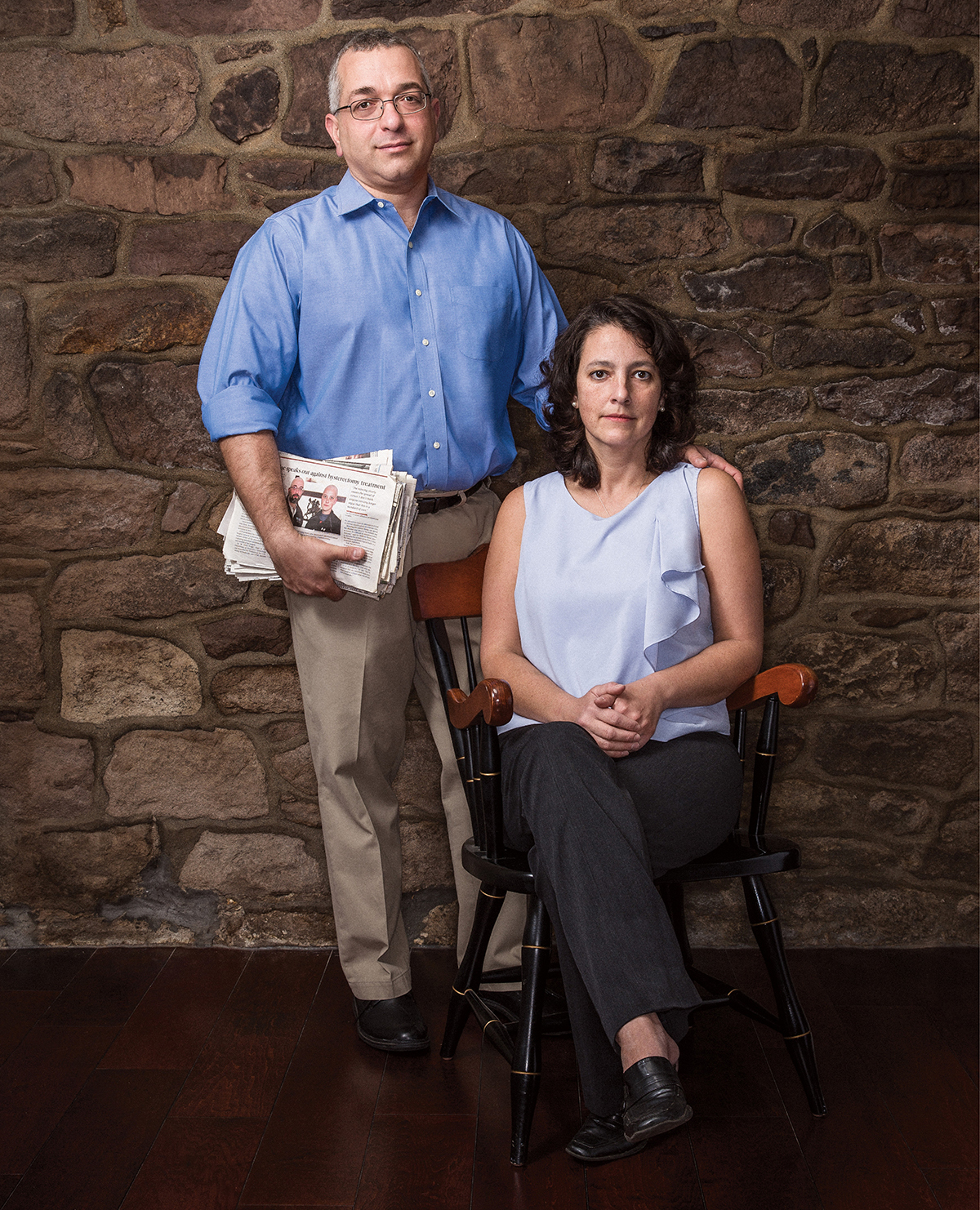What Are the Chances?

Hooman Noorchashm, pictured at home with his wife, Amy Reed, holds newspapers with stories about Amy’s struggles at Brigham and Women’s. / Photographs by Colin Lenton
Hooman Noorchashm would not shut up.
The emails went sailing out from his laptop at all hours of the day and night, to physicians, to government regulators, to legislators, insurers, hospital administrators, reporters, anyone who might possibly listen to what he had to say. His messages were inflammatory, harsh. Court records show that he accused his fellow doctors of being corrupt, unconscionable criminals. The emails seemed a bit…unhinged. Those he was sending them to tried to stop him. They threatened legal action, then went to court. They described his messages as “disturbing and threatening.” They called him a security threat.
None of that mattered to Hooman. He was on a mission. He had something to prove. At one of the finest, most reputable healthcare facilities in the nation, Brigham and Women’s Hospital, a physician had used a medical device known as a power morcellator to mince and suction up his wife’s uterine fibroid—a type of benign growth experienced by more than half of all women. Unbeknownst to the doctor or to Hooman’s wife, Amy Reed, a rare cancer known as a leiomyosarcoma was implanted in her uterine wall. The power morcellator minced it up along with the fibroid, its spinning blades tossing bits and pieces of the cancer throughout her abdominal cavity.
Since that initial operation in 2013, Amy has had four more operations to remove new tumors generated by the morcellator’s “upstaging” of her original cancer. The makers of power morcellators and the doctors who favor the devices insisted that the chances someone like her had such a tumor were minuscule, negligible—one in 10,000. Those chances sound pretty good.
But Hooman and Amy have since learned that for women suffering from fibroids serious enough to prompt surgery, the odds are more like one in 350. That’s not a chance you or I would be likely to take.
The overriding duty of a physician is so well known that it’s a cliché: First, do no harm. But Amy and Hooman say her oncologist knew about the greater risk when she was operated on. That there were other women like her—including one who lay dying at Brigham and Women’s while Amy had her initial operation, performed with the same device that had caused that other woman’s cancer to spread. And that because the device made the operation easier and faster and cheaper, and all of medicine today is geared toward easier and faster and cheaper, no one was looking for problems that device might cause.
Amy’s a doctor herself, married to a doctor—one who worked in the same hospital where she was operated on. If she and Hooman weren’t told the truth about what might happen to her, what are the chances you or I would be? How blind is our faith in physicians, and how daunting our inability to know what questions to ask? That’s the bone that’s stuck in Hooman’s craw, and it’s what turned his email campaign against morcellation into an all-out war against the wobbly, opaque healthcare system that endangers us all.
When Hooman Noorchashm first heard of morcellation, he didn’t know how to spell it. “I used an S,” he says as he sits at the kitchen table of the couple’s home in Morrisville, Bucks County. It’s an ancient farmhouse in the midst of a newer subdivision, surrounded by lawn and trees. There’s spaghetti on the blacktop driveway from where their kids—they have six—spilled it on their way to feed leftovers to the chickens in the family chicken coop. Their youngest, three-year-old Ryan, threw up last night; he’s cranky from a virus. Amy settles him in with a cartoon in the family room, part of an addition whose construction she just oversaw.
Hooman, who’s 43, and Amy, 42, weren’t living here when she was diagnosed in 2013; they were in Needham, where they moved after graduating from the University of Pennsylvania’s medical school and completing their residencies at HUP. She had her fibroid operation at Brigham and Women’s 13 months after Ryan was born. “I was still breastfeeding,” she recalls. She’d been miserable from pain and bleeding ever since his birth. On the basis of a colleague’s referral, Amy went to see gynecological oncologist Michael Muto, who examined her, diagnosed a fibroid and not cancer, and sent her on, in turn, to his young colleague Karen Wang, a Brigham-based gynecological surgeon. Amy and legal say that Muto and Wang talked Amy out of the traditional open-abdomen surgery she expected—“I said, ‘Cut me open! My stomach is a mess, I have six kids’”—in favor of a less invasive laparoscopic procedure. (According to court records, Muto and Wang contest this allegation.) Recovery will be quicker, Amy recalls Muto saying. We’ll get you back on your feet. She says no one mentioned a morcellator then. (Muto has admitted he didn’t discuss morcellation at her initial consultation. He and Brigham declined to be interviewed for this story on the advice of counsel.)
Hooman, a cardiothoracic surgeon, was, like Amy, teaching at Harvard Medical School, and working at Brigham and Women’s. When she scheduled her fibroid operation, though, he was in North Carolina, learning to transplant lungs. “I had to go to Duke for six months,” he explains. “It was like playing in the NBA. Harvard wanted me trained at Duke. They sent me there.”
“I was not happy,” Amy puts in. “I didn’t think it was necessary.” There she was in Needham, far from her mother and sisters back in Bucks County, with six kids, the oldest 12, the youngest Ryan. For months she’d been feeling low. Her obstetrician noticed that she was anemic and put her on iron and birth-control pills. They didn’t help. In late summer, she went back to that doctor and said, “Something’s wrong. I’m not normal.” There were MRIs, biopsies, ultrasounds, and then the operation that was supposed to fix it all.
At the kitchen table, Hooman pulls up the notes from Michael Muto’s initial meeting with Amy. He has reams of documents and data about Amy’s case, about morcellators, about leiomyosarcomas, on his laptop. He does most of the talking on this bright December morning. Amy flits around the kitchen, dusting, sweeping, straightening, only alighting at the table from time to time. “When Muto met with me,” she tells me, “he said, ‘You do not have cancer. You don’t need me.’” She sprays organic cleaner on the glass tabletop. “We’re doctors,” she says tightly. “We don’t say ‘never’ unless we’re sure.”
Hooman flew home from North Carolina for Amy’s fibroid operation. It went smoothly. But she didn’t want him to go back afterward. She’d been through so much in Boston. The kids got sick; she’d been alone. “I told him, ‘I would never ask this of you,’” she says. After all the years of training, after hundreds of thousands of dollars in student debt, there was finally light at the end of the tunnel: their teaching jobs at Harvard, his position at Brigham, hers at Beth Israel Deaconess Medical Center. But she couldn’t quarrel with his dedication. That spring, she’d been the critical-care attending on duty the morning of the marathon bombings. She’d treated the victims—and then the wounded bomber, Dzhokhar Tsarnaev, after he was brought in. Do no harm.…
Amy’s operation was on October 17. About a week later, she got a call from Karen Wang, the doctor who’d performed her surgery. “Are you alone?” Wang asked. The pathology report on her fibroid had come back. It showed an unusually aggressive form of cancer—leiomyosarcoma. Wang said she was sorry. Then Muto contacted Amy at Wang’s request. Muto said Amy would need another operation; they’d have to take out her ovaries.
Amy called Hooman in North Carolina. He was in the midst of an operation when his phone started buzzing and beeping. It didn’t stop. “Who’s calling you?” a nurse finally asked. He scrubbed out and took the call. He knew what leiomyosarcoma was. His phone rang again—it was Karen Wang. “I said, ‘Did you get it out in one piece?’” Hooman says. “I assumed—the way you treat any mass, you take it out in one piece. You never chop it up. She said, ‘No, we morcellated it.’” That was when Hooman first wrote the word down, with an S. He told his colleagues he had to leave and headed for the airport.
“It wasn’t part of my working knowledge,” he explains. “I knew doctors used to do that to spleens to get them out. So I sort of knew what we were up against.” He knew, too, that he was done at Duke. In the cab, he called Michael Muto. Muto told him that what had happened was very, very rare, Hooman recalls. That Amy was just so unlucky.
If the sarcoma had been taken out whole, her five-year survival rate would have been 50 percent. With the cancer morcellated, it was between zero and 20 percent. “Basically,” says Hooman, “they created a man-made Stage 4 cancer.”


